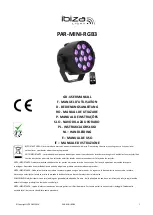
AirWave System Operator’s Manual
7
All Lungs Are Not the Same
Accurate tracking of the airway echo by the system assumes that the echo shape remains consistent over the
duration of patient monitoring. Significant changes in the echo shape may result in the system reporting a change
in ETT position when the actual position has not changed. It is possible that the airway echo shape may change
due to airway changes that affect the geometry of the airway echo region. Some examples of airway changes
that may affect the airway echo shape include mucus plugs in a bronchus, or a significant change in middle
airway A due to bronchoconstriction or dilation. Therefore, when the system indicates ETT movement, it is
recommended that the user enter the
Patient Monitoring Waveform Screen
to compare the baseline echo
(indicated in light blue) and present airway echoes (indicated in yellow) to confirm the current echo has shifted in
time (moved left/right compared to the baseline echo) and that the baseline and current airway echoes have
similar shapes.
AirWave Sounds are Audible
While a majority of medical devices that employ acoustics do so in the ultrasonic frequency range, the AirWave
operates in the audible range below 8 kHz due to reasons related to the frequencies at which the ETT and
airways behave as waveguides. Operating in these frequencies creates a challenge for collecting echo signals
that are not corrupted by the sounds typically found within a ventilator circuit, such as respiratory sounds,
secretion sounds, cuff leak sounds, etc. As a result, the AirWave system uses a variety of data collection
strategies to collect a clean echo signal during ventilation. When connected to a patient, the system collects a
majority of its measurements during the quiet period of ventilation between end-expiration and inspiration.
Therefore, the AirWave Monitor provides updates to the ETT status approximately every patient breath depending
on the level of noise present between breaths. For cases where excessive noise interferes with acoustical
measurements such that the ETT status is not updating, it is recommended that the user enter the
Listen to
AirWave Microphones Screen
to listen directly to the Sensor microphones via the Monitor speaker. This assists
the user in determining the noise source so they can rectify it if possible. Examples of noise sources may include:
a leaky ETT cuff, secretions in the airway and/or ETT, a high respiratory rate, a nebulizer, and patient coughing.
E. Airwave Monitor Package Contents
(1) AirWave Monitor
(1) Carrying strap
(1) AC-DC Power Supply
(1) Hospital Grade Power Cord
(1) Sensor Cable
(1) Firmware Upgrade & Data Cable (RS232 Connection with USB-to-RS232 Converter Cable)
(1) Software and Documentation CD












































